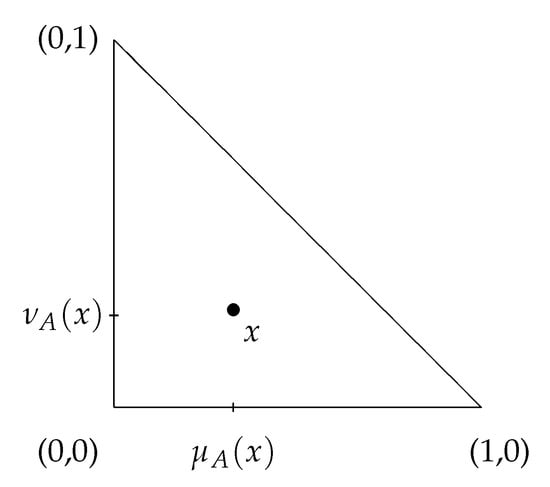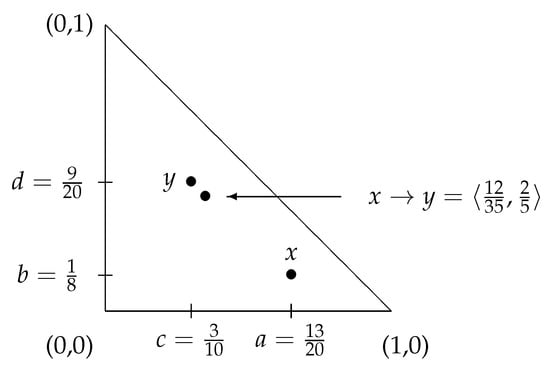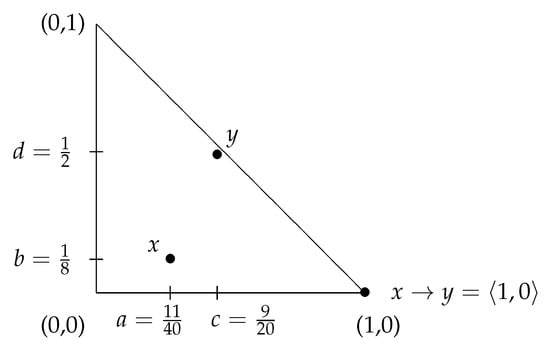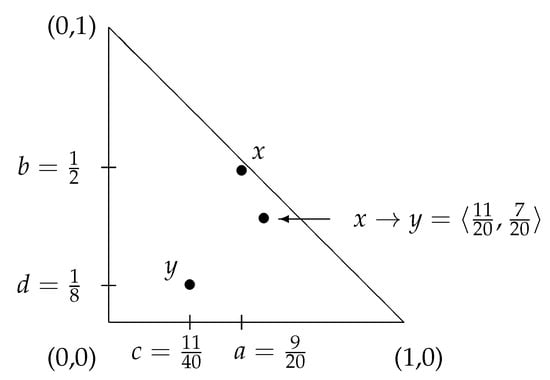Abstract
In the present paper we construct a new intuitionistic fuzzy implication, giving intuitionistic fuzzy form to Goguen’s implication. Some of its basic properties are studied and illustrated with examples. Geometrical interpretations of the different forms of the new implication are given. Other forms of the Goguen’s implication are discussed.
MSC:
03E72
1. Introduction
Joseph Amadee Goguen (28 June 1941–3 July 2006) is the first PhD student of Lotfi Zadeh, working in the area of fuzzy sets. Its name is related to the following fuzzy implication (see, e.g., []):
In the present paper, for the first time, an intuitionistic fuzzy form of the Goguen’s implication will be introduced.
Some years after the introduction of the concept of intuitionistic fuzziness, intuitionistic fuzzy logics (propositional, predicate, modal and temporal) were developed (see []). In the frames of the propositional intuitionistic fuzzy logic now there have been defined more than 190 different intuitionistic fuzzy implications. Except for the authors, intuitionistic fuzzy implications have been researched in details also by L. Atanassova, who in [,,,] introduced 11 implications (), and by P. Dworniczak [,,] (who generalized these to implications ). In [,], L. Atanassova modified Dworniczak’s implications to .
The aim of this whole direction of research over the intuitionistic fuzziness is to define a large set of possible implications and determined among them such a subset of implications that have the most suitable form and properties allowing for real use in different decision making applications.
In some definitions we shall use functions and :
Let everywhere intuitionistic fuzzy truth values of variables x and y be:
The geometrical interpretation of an element with degrees and are shown on Figure 1 (see []).

Figure 1.
The geometrical interpretations of elements .
In [], these pairs are called Intuitionistic Fuzzy Pairs (IFPs). The IFP is:
- A tautology if and only if (iff) and ;
- An intuitionistic fuzzy tautology (IFT) iff
For the two IFPs x and y, let
2. Main Results
Let us suppose everywhere below that for each ,
Let us define for the IFPs x and y:
First, we shall show that the definition of the new implication is correct.
Let such that and . Then, obviously:
On the other hand, let
If , then
and if , then
Finally, let
If , then , and , i.e.,
If , then, and , i.e.,
Therefore, the definition of the new implication is correct.
Now, we see that
When we have fuzzy but not intuitionistic fuzzy variables, i.e., , then
Therefore, we obtain the standard Goguen’s implication.
In Figure 2, Figure 3, Figure 4 and Figure 5, we illustrate the proposed here intuitionistic fuzzy Goguen’s implication for the four basic possible scenarios for the mutual placement of the elements x and y, with particular numerical values.

Figure 2.
The geometrical interpretations of elements x, y and : first scenario.

Figure 3.
The geometrical interpretations of elements x, y and : second scenario.

Figure 4.
The geometrical interpretations of elements x, y and : third scenario.

Figure 5.
The geometrical interpretations of elements x, y and : fourth scenario.
The new implication generates the following negation.
Now, we check directly the following equalities:
Theorem 1.
The new implication
- (a)
- satisfies as a tautology;
- (b)
- satisfies as a tautology;
- (c)
- does not satisfy even as an IFT.
Proof.
First, we see that for each real number p:
and
For (a) we see that
Therefore, is a tautology.
For (b) we obtain:
If , then
If , then
Therefore, is a tautology.
For (c) we see directly that
If , then If , then
If , then
Obviously, if , then is not an IFT.
Finally, if , then
Therefore, , it is not an IFT and hence, it is not a tautology either. □
Theorem 2.
The new implication
- (a)
- satisfies Modus Ponens in the sense of a (classical) tautology,
- (b)
- does not satisfy Modus Ponens in the sense of an intuitionistic fuzzy tautology.
Proof.
(a) Let be a tautology, i.e., and and let be a tautology, i.e., and . Then
If and hence , the equality is valid, while if , then the right-hand side of the equality is equal to , that is a contradiction. Therefore, is a tautology.
(b) Let , i.e., an IFT. Then,
will be an IFT, e.g., for , but the latest pair is not an IFT, i.e., the Modus Ponens is not valid. □
Some variants of fuzzy implications are described in the book of Klir and Yuan [] and the following nine axioms are discussed, where denotes for any of the possible forms of the operation implication, N is the operation negation related with operation →:
- Axiom ,
- Axiom ,
- Axiom ,
- Axiom ,
- Axiom ,
- Axiom ,
- Axiom iff ,
- Axiom ,
- Axiom I is a continuous function.
For the purposes of our research, having in mind the specific forms of the intuitionistic fuzzy implication → and following [], we modify three of these axioms, as follows.
- Axiom ,
- Axiom if , then, is an IFT),
- Axiom is a tautology.
In this way, the so modified axioms hold, but in weaker conditions, i.e., if the axioms hold, then the weaker axioms also hold, but this is not always true in the other direction.
Theorem 3.
The new intuitionistic fuzzy implication satisfies axioms , , , , and and it does not satisfy axioms , , , , and .
Proof.
For the validity of we obtain the following.
Let and . Then
Now, we study the expressions
and
For X we obtain the following.
Let . Then
If , then
If , then, due to ,
Let . Then and
If , then
If , then from it follows that
Therefore, in all cases .
For Y we obtain the following.
Let . Then obviously
When , then and therefore the axiom is not true.
For the validity of we obtain the following.
Let and . Then
Now, we study the expressions
and
For X we obtain the following.
Let . Then
If , then
If , then
Let . Then and
Therefore, in all cases .
For Y we obtain the following.
Let . Then
If , then
If , then
Therefore, in all cases and hence is valid.
The check of is trivial:
For axioms and we obtain the following.
If , then while if , then
Therefore, axiom is not valid, but axiom is true.
The check of axiom is trivial:
while the checks that axioms , and are similar to the check of the non-validity of axiom . For example, for and , , but .
Finally, we will check the validity of .
Let
If , then , i.e., and
If , then i.e., and
If , then
If , then
and since from it follows that and , then
Therefore, is valid as a tautology. □
3. Conclusions
In this paper, we have introduced a new intuitionistic fuzzy implication that has intuitionistic but not classical behaviour.
In a future leg of the present research, new properties of the new implication will be studied. We will check which axioms of Brower’s intuitionistic logic and which Kolmogorov’s axioms are valid. We will study the relations between the newly proposed implication and the existing ones.
The intuitionistic fuzzy Goguen’s implication will be modified similarly to the the modification of the other implications, discussed in [].
In future, three new intuitionistic fuzzy conjunctions and disjunctions will be defined in the sense of [,,].
Author Contributions
Conceptualization, K.A.; methodology, K.A.; software, N.A.; validation, K.A.; formal analysis, K.A.; investigation, K.A., N.A., V.A.; writing—original draft preparation, K.A.; writing—review and editing, V.A.; visualization, V.A.; supervision, K.A.; project administration, K.A. All authors have read and agreed to the published version of the manuscript.
Funding
The research is supported by the National Science Fund of Bulgaria under Grant Ref. No. DN-02-10/2016.
Acknowledgments
The authors are thankful to the anonymous reviewers for their valuable remarks that improved the readability of the paper.
Conflicts of Interest
The authors declare no conflict of interest.
References
- Klir, G.; Yuan, B. Fuzzy Sets and Fuzzy Logic; Prentice Hall: Upper Saddle River, NJ, USA, 1995. [Google Scholar]
- Atanassov, K. Intuitionistic Fuzzy Logics; Springer: Cham, Switzerland, 2017. [Google Scholar]
- Atanassova, L. A new intuitionistic fuzzy implication. Cybern. Inf. Technol. 2009, 9, 21–25. [Google Scholar]
- Atanassova, L. On some properties of intuitionistic fuzzy negation ¬@. Notes Intuitionistic Fuzzy Sets 2009, 15, 32–35. [Google Scholar]
- Atanassova, L. On two modifications of the intuitionistic fuzzy implication →@. Notes Intuitionistic Fuzzy Sets 2012, 18, 26–30. [Google Scholar]
- Atanassova, L. On the modal form of the intuitionistic fuzzy implications and . Issues Intuitionistic Fuzzy Sets Gen. Nets 2013, 10, 5–11. [Google Scholar]
- Dworniczak, P. Some remarks about the L. Atanassova’s paper “A new intuitionistic fuzzy implication”. Cybern. Inf. Technol. 2010, 10, 3–9. [Google Scholar]
- Dworniczak, P. On one class of intuitionistic fuzzy implications. Cybern. Inf. Technol. 2010, 10, 13–21. [Google Scholar]
- Dworniczak, P. On some two-parametric intuitionistic fuzzy implications. Notes Intuitionistic Fuzzy Sets 2011, 17, 8–16. [Google Scholar]
- Atanassova, L. Remark on Dworniczak’s intuitionistic fuzzy implications. Part 1. Notes Intuitionistic Fuzzy Sets 2015, 21, 18–23. [Google Scholar]
- Atanassova, L. Remark on Dworniczak’s intuitionistic fuzzy implications. Part 2. Issues Intuitionistic Fuzzy Sets Gen. Nets 2016, 12, 61–67. [Google Scholar]
- Atanassov, K.; Szmidt, E.; Kacprzyk, J. On intuitionistic fuzzy pairs. Notes Intuitionistic Fuzzy Sets 2013, 19, 1–13. [Google Scholar]
- Angelova, N.; Stoenchev, M. Intuitionistic fuzzy conjunctions and disjunctions from first type. Annu. Inform. Sect. Union Sci. Bulg. 2016, 8, 1–17. [Google Scholar]
- Angelova, N.; Stoenchev, M.; Todorov, V. Intuitionistic fuzzy conjunctions and disjunctions from second type. Issues Intuitionistic Fuzzy Sets Gen. Nets 2017, 13, 143–170. [Google Scholar]
- Angelova, N.; Stoenchev, M. Intuitionistic fuzzy conjunctions and disjunctions from third type. Notes Intuitionistic Fuzzy Sets 2017, 23, 29–41. [Google Scholar]
Publisher’s Note: MDPI stays neutral with regard to jurisdictional claims in published maps and institutional affiliations. |
© 2021 by the authors. Licensee MDPI, Basel, Switzerland. This article is an open access article distributed under the terms and conditions of the Creative Commons Attribution (CC BY) license (http://creativecommons.org/licenses/by/4.0/).